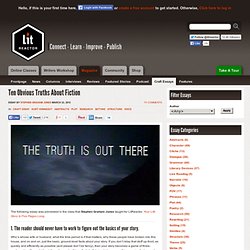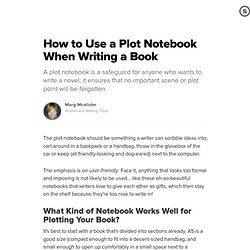

Applied Phlebotinum. Advice on Novel Writing. < Back to darkwaves.com Foreword by the Author Developing Efficient Work Habits Elements Of A Successful Story In the opening... Short Stories: Wondering How to Fit Your Big Ideas into a Small Space? Using Real Psychology in Your Writing. Using Real Psychology in Your Writing Using Archetypes in Your Stories Writing Better Romantic Relationships This series looks at the Anima/Animus archetype, which is most often seen in romantic relationships, and how to use it to create more compelling romantic relationships, regardless of genre.

Looks at what the anima and animus are, how they're formed, and why fiction writers need to understand them. There's also some and what makes love grow - and how happily ever afters really work. Creating Better Antagonists. Ten Obvious Truths About Fiction. The following essay was previewed in the class that Stephen Graham Jones taught for LitReactor, Your Life Story Is Five Pages Long. 1.

The reader should never have to work to figure out the basics of your story. Who’s whose wife or husband, what the time period is if that matters, why these people have broken into this house, and on and on, just the basic, ground-level facts about your story. If you don’t relay that stuff up-front, as quickly and efficiently as possible (and please don’t be fancy), then your story becomes a game of three-card-monty, with you hiding information under this or that shell, trying to keep everything moving fast enough that nobody knows what’s going on.
Fantasy Writing Contest. Plot Points and the Inciting Incident - StoryFanatic. Plot points can sometimes be difficult to pick out, especially when there is confusion as to the purpose of such a device in a story.

If one accepts the idea that stories are about solving problems, the reason for Inciting Incidents and Act Turns becomes all too clear. A Simple Novel Outline - 9 questions for 25 chapters & H.E. Roulo - StumbleUpon. Just as every tree is different but still recognizably a tree, every story is different but contains elements that make it a story.

By defining those before you begin you clarify the scope of your work, identify your themes, and create the story you meant to write. At Norwescon 2011 I sat in on a session called Outline Your Novel in 90-minutes led by Mark Teppo. I’ll give you the brief, readable, synthesized version. Answer 9 questions and create 25 chapter titles and you’re there. Here are the 9 questions to create a novel: 1.) 2.) 3.) 4.) 5.) 6.) 7.) How to Use a Plot Notebook When Writing a Book: A Simple Plotting Tool to Make Fiction Writing Easier.
The plot notebook should be something a writer can scribble ideas into, cart around in a backpack or a handbag, throw in the glovebox of the car or keep (all friendly-looking and dog-eared) next to the computer.

The emphasis is on user-friendly. Face it, anything that looks too formal and imposing is not likely to be used... like those oh-so-beautiful notebooks that writers love to give each other as gifts, which then stay on the shelf because they're too nice to write in! What Kind of Notebook Works Well for Plotting Your Book? Tension - StumbleUpon. Hook Your Readers With Tension By Laura Backes, Write4Kids.com Tension.

Without it, life would be—let's face it—boring. So would fiction. Tension works with conflict to raise the emotional level of the text to a boiling point. It forces the reader to become invested in the story. "Tension" is a loaded word, and can be misleading. Tension is what hooks readers of any age and keeps them turning the pages. . * The ticking clock. . * Dialogue. . * Pacing. . * Sentence structure. Each story requires a different kind of tension. Laura Backes is the author of Best Books for Kids Who (Think They) Hate to Read from Prima/Random House. Copyright © 2002, Children's Book Insider, LLC. How to Write Conflict: Understanding the Most Important Part of Writing Fiction - StumbleUpon. The struggle and change of your protagonist is what makes a story a story.

Many writers get caught up in giving their readers details of crisis when the true draw of a story, the thing we as readers want to know, is the metamorphosis of the character. Conflict Versus Crisis The difference is that crisis is usually a circumstantial event or action, such as a car accident, a robbery, a break-up in a relationship. Conflict is the choices or struggles the character has to make, sometimes because of crisis. Conflict happens inside the character. The two biggest mistakes new authors make are weaving in too many conflicts or focusing too much on crisis. When an author truly encompasses good conflict, the reader is left thinking about the story for days after putting down the book; left wondering what would happen next. Psychology Today - StumbleUpon.
Writing a novel?

There's first-draft flow, and there's editing flow. And then there comes a time when you think you might be done, yet the manuscript is still not quite "there. " To sell your work to an agent, and then to a publisher, and finally to a great many readers, put thoughts of flow aside now, and consider the following advice. Each of the guides mentioned is worthy of your careful attention. , such as "Danielle was a woman of medium height with brown hair and brown eyes. "